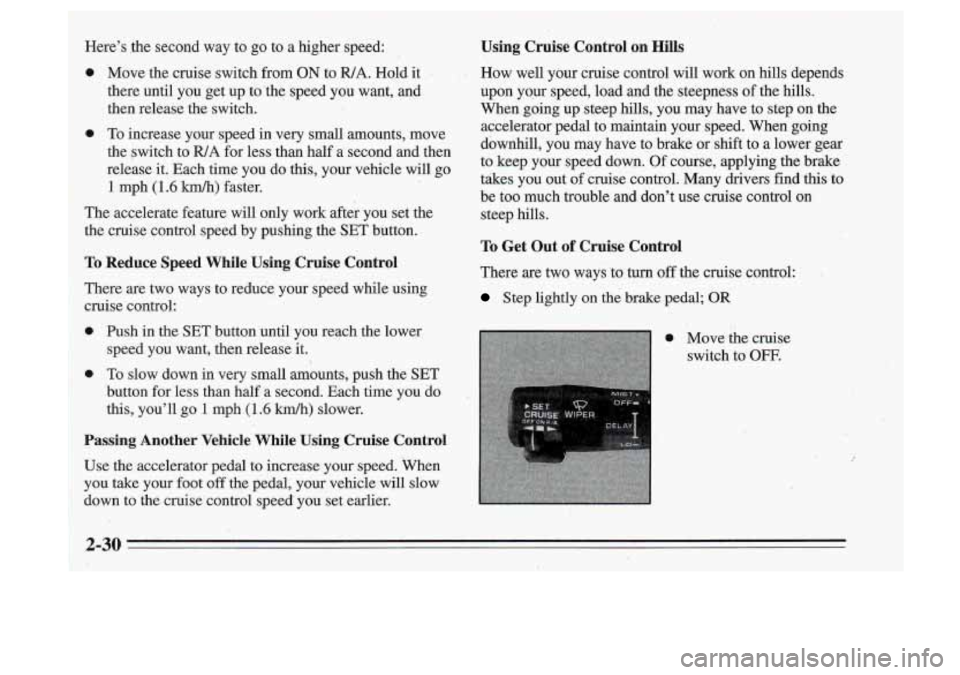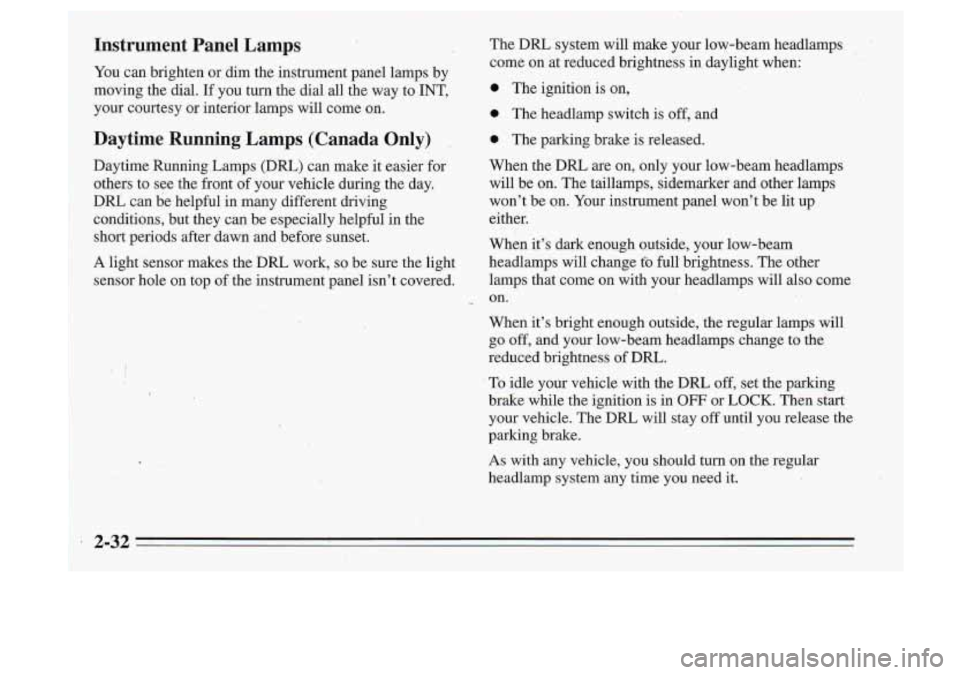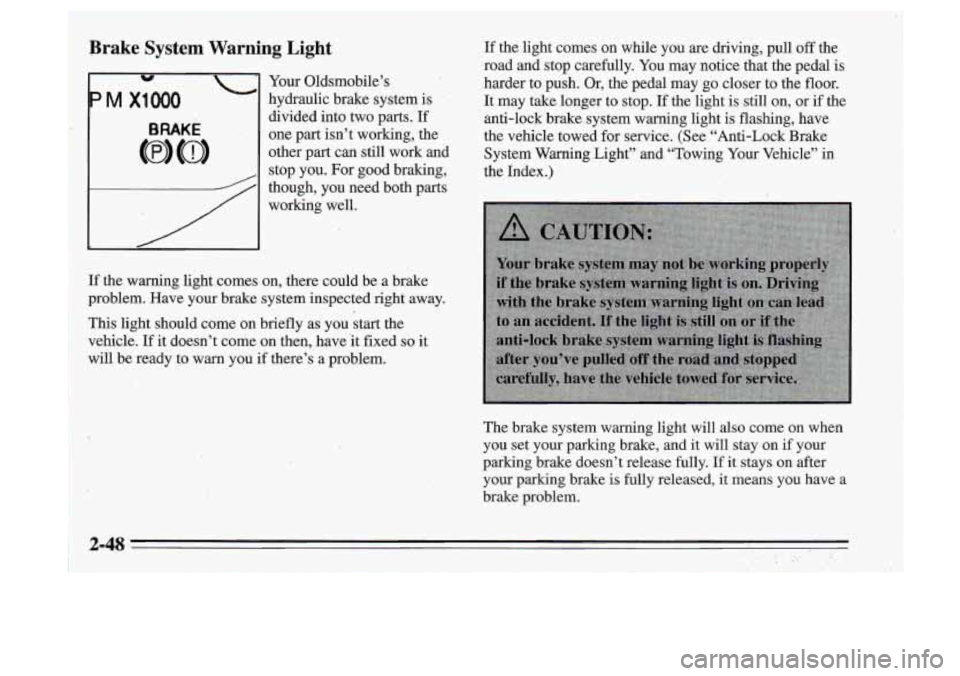Page 88 of 340

..
Here's ,the second way to go to a higher speed:
0
0
The accelerate feature will only work after you set the
the cruise controhpeed by pushing the
SET button.
To Reduce Speed While Using Cruise Control
There are two ways to reduce, your speed while using
cruise control:
0 Push in the SET button until you reach the lower.
Move the cruise switch
from
ON to R/A. Hold it
there until you get up to-the speed you want, and
then release the switch.
To increase your speed in very small amounts, move
the switch to
R/A for less than half a second and then
release it. Each time you do
this, your vehicle will go
1 mph (.1.6 km/h) faster.
speed you want, then release it.
0 To slow down in very small amounts, push the SET
button
for less than half a second. Each time you do.
this, you'll go
1 mph (1.6 km/h) slower.
Passing Another Vehicle While Using Cruise Control
Use the accelerator pedal to increase your speed. men
you take your foot
off the pedal, your vehicle will slow
down to the cruise control speed- you set earlier.
Using Cruise Control on Hills
How well your cruise control will work on hills depends
upon your speed, load and the steepness of the hills.
When going up steep hills, you may have
to step on the
accelerator pedal to maintain your speed. When going
downhill, you may have to brake or shift to a lower gear
to keep your speed down. 'Of course, applying the brake
takes you out of cruise control. Many drivers
find this to
be too much trouble and don't use cruise control on
steep hills.
To Get Out of Cruise Control
There are two ways 'to turn off the cruise control: - :x.
Step lightly on the brake pedal; OR
Page 90 of 340

Instrument Panel Lamps
You can brighten or dim the instrument panel lamps by
moving the dial. If you turn the dial all the way to INT,
your courtesy or interior lamps will come on.
Daytime Running Lamps (Canada Only)
Daytime Running Lamps (DRL) can make it easier for
others to see the front of your vehicle during the day.
DRL can be helpful in many different driving
conditions, but they can be especially helpful in the
short periods after dawn and before sunset.
A light sensor makes the DRL work, so be sure the light
sensor hole on top
of the instrument panel isn't covered. The
DRL system will make your low-beam headlamps
come on
at reduced brightness in daylight when:
0 The ignition is on,
0 The headlamp switch is off, and
0 The parking brake is released.
When the
DRL are on, only your low-beam headlamps
will be on. The taillamps, sidemarker and,other lamps
won't
be on. Your instrument panel won't be lit up
either.
When it's dark enough outside, your low-beam
headlamps will change
fo full brightness. The other
lamps that come on with your headlamps will also come
on.
When it's bright enough outside, the regular lamps will
.go
off, and your low-beam headlamps change to the
reduced brightness of
DRL.
; To idle your vehicle with the DRL off, set the parking
brake while the ignition is in
OFF or LOCK. Then start
your vehicle. The
DRL will stay off until you release the
parking brake.
As with any vehicle, you should turn on the regular
headlamp system any time you need it.
. 3 13
Page 101 of 340
HOT APPLY BRAKE TO SHIFT FROM PARK ,/ \ UNLEADED FUEL ONLY
United States Version Shown, Canadian Similar
Your instrument cluster is designed to let you know at a glance how your vehicle is running. You’ll know how -fast
you’re
going, about how much fuel is in your tank and many other things you need to drive safely and economically.
2-43
- -.
Page 106 of 340

Brake System Warning Light
Your Oldsmobile’s
hydraulic brake system is
divided into two parts. If
one part isn’t working, the
other
part can still work and
stop you. For good braking,
though, you need both parts
working well. If
the light comes on while you
are driving, pull off the
road and stop carefully. You may notice that the pedal is
harder to push. Or,
the pedal may go closer to the floor.
It may take longer to stop.
If the light is still on, or if the
anti-lock brake system warning light
is flashing, have
the vehicle towed for service. (See “Anti-Lock Brake
System Warning Light” and “Towing Your Vehicle” in
the Index.)
If the warning light comes on, there could be a brake
problem. Have your brake system inspected right away.
:This light should come on briefly as you start the
vehicle. If it doesn’t come on then, have it fixed
so it
mill be ready to warn you
if there’s a problem.
The brake.system warning light will also come on when
you set your parking brake,
and it will stayion if your
parking brake doesn’t release fully. If it stays on after
your parking brake is fuily released, it means you have a
brakerproblem.
2-48
Page 108 of 340
Anti-Lock Brake System Active Light
When your anti-lock system
is adjusting brake pressure
to help avoid a braking skid,
the LOW TRAC light will
come on.
Slippery road conditions will exist if this light comes on,
so adjust your driving accordingly. The light will stay on
for a few seconds after the system stops adjusting brake
pressure.
The LOW TRAC light also comes on briefly, as a bulb
check, when the engine is started. If the light doesn’t
come on then, have it fixed
so it will be there to tell you
when the system is active.
‘ This light tells.you that
your engine coolant has
, overheated or your radiator
cooling fan is not working.
If you have been operating your vehicle under normal
driving conditions, you should pull
off the road;stop’
your vehicle and turn.off the engine as soon as possible.
Hot Coolant Can Burn You Badly!
In “Problems on the~Road,” this manual shows what to
do. See “Engine Overheating”
in the Index.
2-50
Page 109 of 340
Engine Coolant Temperature Gage
APPLY BRAKE TO SHIF1
You have a gage that shows
the engine coolant
temperature.
If the gage
pointer moves into the red
area, your engine is too hot!
Low Coolant Warning Light
If this light comes on, your
system is low on coolant
and the engine may
overheat. See “Engine
Coolsint” in the Index and
have your vehicle serviced
as soon as you can.
i COOLANT
That reading means the same thing as the warning light.
It means that your engine coolant has overheated. If you
have been operating your vehicle under normal driving
conditions, you should pull
off the road, stop your
vehicle and turn
off the engine as soon as possible.
Hot Coolant Can Burn You Badly!
In “Problems on the Road,” this manual shows what to
do. See “Ennine Overheatine” in the Index.
Page 139 of 340
I Section 4 Your Driving and the Road
~~~ ~~~~ -
Here you’ll find information about driving on different
kinds of roads and in varying weather conditions. We’ve
also included many other useful tips onldriving.
Defensive Driving
The best advice anyone can give about driving is: Drive
defensively.
Please start with
a very important safety device in your
Oldsmobile: Buckle up. (See “Safety Belts” in the
Index.)
Defensive driving really means “be ready for anything.”
On city streets, rural roads, or freeways, it means
“always expect the unexpected.”
Assume that pedestrians or other drivers are going to be
careless and”make mistakes. Anticipate what they might
do. Be ready for their mistakes.
Rear-end collisions are about the most preventable of
accidents. Yet they are common. Allow enough
following distance. It’s the best defensive driving
maneuver, in both city and rural driving. You never
know when the vehicle in front of you is going to brake
or turn suddenly.
4-1
Page 144 of 340
I
Anti-Lock Brakes (A S)
Your Oldsmobile has an advanced electronic braking
system that
will help prevent a braking skid.
This light on the instrument
panel will come on briefly
when you start vour vehicle.
RPM X1000
When you start your vehicle, or when you begin to drive
away, you may hear a momentary motor or clicking
noise. And you may even notice that your brake pedal
moves a little while this is going on. This
is the ABS
system testing itself. If there’s a problem with the
anti-lock brake system, the anti-lock brake system
warning light will stay on or flash.
See “Anti-Lock Brake System Warning Light”
in the
Index.
..